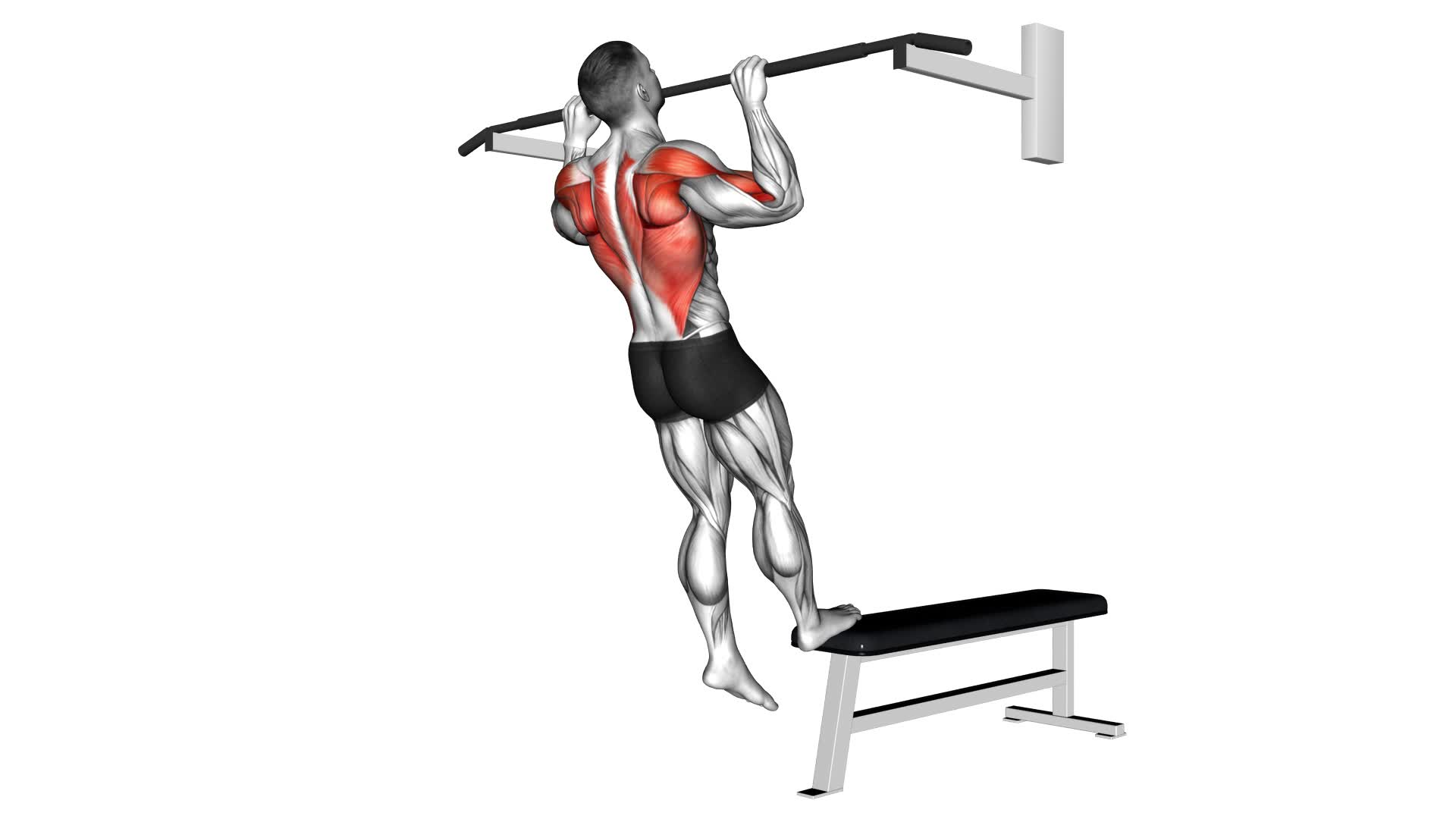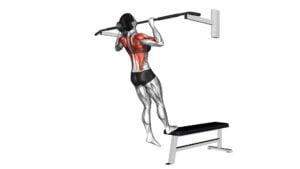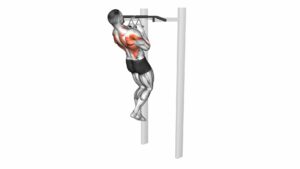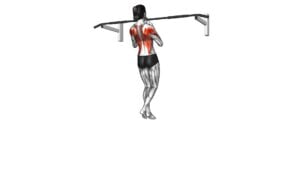Bench Pull-ups – Video Exercise Guide & Tips

Are you looking to level up your upper body strength? Look no further than bench pull-ups!
Watch This Exercise Video
This video exercise guide and tips will show you how to master this challenging move. With proper form and technique, you'll be able to target your back and arms effectively.
Whether you're a beginner or advanced, there are modifications and variations to suit your fitness level.
Get ready to take your pull-up game to the next level!
Key Takeaways
- Bench pull-ups strengthen upper body muscles, particularly the back and arms.
- They target multiple muscle groups for effective strength and muscle definition.
- Bench pull-ups improve overall upper body strength for easier daily tasks and exercises.
- They enhance posture by strengthening the muscles that support the spine.
Benefits of Bench Pull-ups
One of the main benefits of bench pull-ups is that they strengthen your upper body muscles, particularly your back and arms. Bench pull-ups are a variation of the traditional pull-up exercise, where you use a bench for support instead of hanging from a bar. This exercise targets multiple muscle groups in your upper body, making it an effective workout for building strength and muscle definition.
When you perform bench pull-ups, your back muscles, such as the latissimus dorsi and rhomboids, are heavily engaged. These muscles are responsible for pulling movements, and by working them during bench pull-ups, you can develop a stronger and more defined back. Additionally, your biceps and forearm muscles are also activated during this exercise, helping to improve the strength and tone of your arms.
By regularly incorporating bench pull-ups into your workout routine, you can experience several benefits. Firstly, it can help improve your overall upper body strength, making daily tasks and other exercises easier to perform. Secondly, it can enhance your posture by strengthening the muscles that support your spine. Lastly, it can contribute to a more sculpted physique, as it targets and tones multiple muscle groups simultaneously.
Essential Equipment for Bench Pull-ups
To perform bench pull-ups effectively, you'll need some essential equipment. This includes a sturdy bench or platform, a pull-up bar, and a comfortable grip.
It's important to choose the right gear that can support your weight and provide stability during the exercise.
Necessary Equipment for Pull-Ups
You will need three essential pieces of equipment for bench pull-ups. To perform this exercise effectively, make sure you have the following items on hand:
- Pull-Up Bar: A sturdy pull-up bar is crucial for bench pull-ups. It provides a stable and secure grip for your hands while you pull yourself up. Look for a bar that can be easily attached to a doorframe or mounted on a wall for convenience.
- Bench: A weight bench is necessary for bench pull-ups as it provides support and stability for your body. Ensure that the bench is adjustable to accommodate different heights and angles for a more challenging workout.
- Resistance Bands: Resistance bands can be used to assist or add resistance to your bench pull-ups. They provide an effective way to modify the intensity of the exercise based on your fitness level. Choose bands with varying levels of resistance to suit your needs.
With these essential pieces of equipment, you'll be well-equipped to perform bench pull-ups safely and effectively.
Choosing the Right Gear
To ensure you have the necessary equipment for bench pull-ups, it's essential to choose the right gear.
When it comes to bench pull-ups, there are a few key considerations.
First, you'll need a sturdy and stable bench. Look for one that can support your weight and has a non-slip surface to prevent any accidents.
Additionally, a pull-up bar is crucial for this exercise. You can opt for a doorway pull-up bar or a wall-mounted one, depending on your space and preferences.
It's also important to have a comfortable and supportive pair of gloves to protect your hands during the exercise.
Keep in mind that bench pull-ups target different muscle groups compared to regular pull-ups, primarily focusing on your back, biceps, and shoulders.
Lastly, remember to incorporate rest periods into your routine to allow your muscles to recover and avoid overexertion.
Proper Form and Technique for Bench Pull-ups
To perform bench pull-ups with proper form and technique, it's important to understand the different grip variations you can use. This will help you target different muscle groups and achieve optimal results.
Additionally, it's crucial to be aware of common mistakes to avoid, such as using momentum or not engaging your core.
Grip Variations for Pull-Ups
For optimal form and technique during bench pull-ups, it's crucial to experiment with different grip variations. The grip you choose can have a significant impact on your grip strength training and muscle activation.
Here are three grip variations to consider:
- Pronated Grip: This is the standard grip, with your palms facing away from you. It primarily targets your latissimus dorsi muscles, helping to build a wider back.
- Supinated Grip: Also known as a chin-up grip, this grip has your palms facing towards you. It emphasizes the biceps and upper back muscles, providing a great way to increase overall pulling strength.
- Neutral Grip: With this grip, your palms face each other, utilizing a parallel handle or a towel. It evenly distributes the load between your biceps, lats, and shoulders, providing a balanced workout.
Common Mistakes to Avoid
Avoid these common mistakes to ensure proper form and technique while performing bench pull-ups.
One common mistake is using momentum to swing your body up, rather than relying on your upper body strength. This not only reduces the effectiveness of the exercise, but also increases the risk of injury.
Another mistake isn't fully extending your arms at the bottom of the movement. This limits the range of motion and prevents you from fully engaging your back muscles.
Additionally, avoid arching your back or excessively leaning forward during the exercise, as this can strain your lower back.
Finally, make sure to maintain a controlled and slow descent, rather than dropping quickly.
Benefits of Bench Pull-Ups
Maximize the benefits of bench pull-ups by focusing on proper form and technique. Bench pull-ups are a great exercise that target the muscles in your upper body, particularly your back and arms.
Here are three key benefits of incorporating bench pull-ups into your workout routine:
- Increased upper body strength: Bench pull-ups engage multiple muscle groups, including your lats, biceps, and shoulders. By regularly performing this exercise, you can develop strong and defined muscles in your upper body.
- Improved posture: Bench pull-ups help strengthen the muscles in your upper back, which can improve your posture. By developing a strong back, you can reduce the risk of developing rounded shoulders and a hunched posture.
- Versatility and variations: Bench pull-ups can be modified to suit different fitness levels and goals. You can adjust the height of the bench or use different hand grips to target specific muscles. This versatility allows you to constantly challenge yourself and prevent workout plateaus.
Beginner Modifications for Bench Pull-ups
To make bench pull-ups more accessible for beginners, you can start by using a resistance band for assistance. This modification helps to decrease the intensity of the exercise and allows you to build strength gradually.
Begin by securing the resistance band around the bar of the bench pull-up station. Step onto the band with both feet and grasp the bar with an overhand grip. The band will provide support as you perform the pull-up motion. As you gain strength, you can gradually decrease the thickness of the resistance band or switch to a band with a higher resistance level.
Another modification for beginners is to perform bench pull-ups with your feet on the ground. This reduces the intensity by taking some of the bodyweight load off your arms.
Start by standing close to the bench pull-up station and gripping the bar with an overhand grip. Bend your knees slightly and use your legs to assist with the pull-up motion. As you progress, you can gradually increase the height of the bench or decrease the assistance from your legs to increase the intensity of the exercise.
Remember to always maintain proper form and engage your back muscles throughout the movement.
Advanced Variations of Bench Pull-ups
Challenge yourself with advanced variations of bench pull-ups to further enhance your upper body strength and overall fitness.
Here are three advanced modifications and alternative exercises to take your bench pull-up routine to the next level:
- Single-Leg Bench Pull-ups: This variation involves performing pull-ups with one leg extended in front of you while gripping the bench. By lifting one leg off the ground, you increase the demand on your core muscles and challenge your balance and stability.
- Weighted Bench Pull-ups: To increase the resistance and intensity of your bench pull-ups, you can add weight by using a weight vest or holding a dumbbell between your feet. This modification helps develop more strength in your upper body, particularly in your back and arms.
- Plyometric Bench Pull-ups: Incorporating plyometric movements into your bench pull-up routine adds an explosive element to the exercise. Start by performing a regular bench pull-up, then explosively push yourself away from the bench and release your grip, allowing your body to momentarily leave the bench. Catch the bench on the way down and immediately transition into the next rep. This advanced variation improves power, speed, and coordination.
Tips for Progressing and Increasing Difficulty in Bench Pull-ups
How can you further challenge yourself and progress in bench pull-ups?
Here are some progression tips to help you increase the difficulty of your bench pull-up workouts.
- Add weight: Once you can comfortably perform a set number of bench pull-ups, you can start adding weight to increase the resistance. You can use a weight vest, a weighted backpack, or hold a dumbbell between your feet.
- Increase reps and sets: Gradually increase the number of reps and sets you do during each workout. Start by adding one or two reps to each set, and gradually increase the total number of sets.
- Decrease rest time: As you get stronger, try to decrease the rest time between sets. This will increase the intensity of your workouts and challenge your muscles even more.
- Modify grip: Experiment with different grip variations to target different muscle groups. You can try an underhand grip, an overhand grip, or a neutral grip to engage your back and arms in different ways.
- Try advanced variations: Once you have mastered the basic bench pull-up, you can try advanced variations such as archer pull-ups, typewriter pull-ups, or one-arm pull-ups. These variations require more strength and stability, providing a greater challenge.
Frequently Asked Questions
How Many Sets and Reps Should I Do for Bench Pull-Ups?
To progress in bench pull-ups, it's important to determine the appropriate sets and reps for your fitness level. Start with 3 sets of 8-10 reps and gradually increase the intensity as you get stronger.
Incorporating bench pull-ups into your workout routine offers several benefits. It strengthens your upper body, specifically your back and arms, while also engaging your core muscles. Additionally, it helps improve your grip strength and overall stability.
Can Bench Pull-Ups Help Improve My Grip Strength?
Incorporating bench pull-ups into your workout routine can have several benefits, including improving your grip strength. Pull-ups engage the muscles in your hands, forearms, and upper body, which can help to strengthen your grip over time.
Additionally, there are different variations of pull-ups that specifically target grip strength, such as towel pull-ups or fingertip pull-ups. These variations challenge your grip even more and can further enhance your overall grip strength.
Are Bench Pull-Ups Suitable for Individuals With Shoulder Injuries?
Should individuals with shoulder injuries do bench pull-ups?
If you have a shoulder injury, it's important to consult with a healthcare professional or a certified trainer before attempting bench pull-ups. They can assess your condition and provide guidance on whether it's safe for you to do this exercise.
If bench pull-ups aren't suitable for you, there may be modified versions of the exercise that can be done to avoid putting stress on your injured shoulder.
Can Bench Pull-Ups Be a Substitute for Traditional Pull-Ups?
Bench pull-ups can be a great substitute for traditional pull-ups in your workout routine. Incorporating bench pull-ups offers several benefits:
- Targeting your back muscles
- Building upper body strength
- Improving grip strength
To perform bench pull-ups effectively, follow these steps:
- Start by grabbing the bar with an overhand grip.
- Extend your arms and hang from the bar.
- Pull your chest towards the bar while keeping your body straight.
- Lower yourself back down.
- Repeat for maximum effectiveness.
How Do Bench Pull-Ups Compare to Other Upper Body Exercises in Terms of Muscle Activation?
Bench pull-ups are an effective upper body exercise that can help activate your muscles. By incorporating them into your workout routine, you can experience the benefits of increased muscle activation in your upper body.
To perform bench pull-ups for maximum muscle activation, make sure to engage your core and pull yourself up using your back muscles. This exercise is a great addition to your routine and can help you achieve your fitness goals.
Conclusion
In conclusion, bench pull-ups are a highly effective exercise for building upper body strength and improving overall fitness. By using a bench as support, individuals of all fitness levels can safely perform this exercise.
Whether you're a beginner or advanced, there are modifications and variations available to suit your needs and help you progress. Remember to maintain proper form and technique, and gradually increase difficulty to continue challenging your muscles and seeing results.

Author
Years ago, the spark of my life’s passion ignited in my mind the moment I stepped into the local gym for the first time. The inaugural bead of perspiration, the initial endeavor, the very first surge of endorphins, and a sense of pride that washed over me post-workout marked the beginning of my deep-seated interest in strength sports, fitness, and sports nutrition. This very curiosity blossomed rapidly into a profound fascination, propelling me to earn a Master’s degree in Physical Education from the Academy of Physical Education in Krakow, followed by a Sports Manager diploma from the Jagiellonian University. My journey of growth led me to gain more specialized qualifications, such as being a certified personal trainer with a focus on sports dietetics, a lifeguard, and an instructor for wellness and corrective gymnastics. Theoretical knowledge paired seamlessly with practical experience, reinforcing my belief that the transformation of individuals under my guidance was also a reflection of my personal growth. This belief holds true even today. Each day, I strive to push the boundaries and explore new realms. These realms gently elevate me to greater heights. The unique combination of passion for my field and the continuous quest for growth fuels my drive to break new ground.







